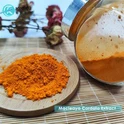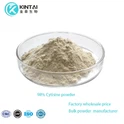Madecassoside powder, derived from the Centella asiatica plant, has gained significant attention in the skincare industry for its potential benefits. As the demand for natural and effective skincare solutions continues to rise, understanding the safety and efficacy of this botanical compound becomes increasingly important. This article delves into the composition, properties, and traditional uses of Madecassoside powder, examining its potential skin benefits, wound healing abilities, anti-inflammatory effects, and safety profile.
Composition and Properties
Madecassoside powder is extracted from the leaves of Centella asiatica, commonly known as Gotu Kola or Indian Pennywort. The active compound, Madecassoside, is a triterpenoid saponin that contributes to the plant's therapeutic properties. Research has shown that Madecassoside powder possesses antioxidant, anti-inflammatory, and wound-healing properties, making it a promising ingredient for skincare formulations.
The antioxidant properties of Madecassoside powder stem from its ability to scavenge free radicals and neutralize reactive oxygen species (ROS). These unstable molecules can cause oxidative stress, leading to cellular damage and premature aging of the skin. By neutralizing free radicals, Madecassoside powder may help protect the skin from environmental stressors, such as UV radiation, pollution, and smoke.
Traditional Uses in Traditional Medicine
Centella asiatica, the source plant of Madecassoside powder, has a long history of use in traditional medicine, particularly in Asian cultures. For centuries, it has been revered for its therapeutic applications, including wound healing, reducing inflammation, and promoting overall well-being. The plant's cultural significance and traditional use underline its potential as a natural remedy for various ailments.
In Ayurvedic medicine, Centella asiatica has been used to treat various skin conditions, such as leprosy, lupus, varicose ulcers, and eczema. It has also been employed to promote wound healing and alleviate inflammation. Traditional Chinese Medicine (TCM) has utilized the plant for its purported ability to improve blood circulation, enhance mental clarity, and support liver and kidney function.
Potential Skin Benefits
Numerous studies have explored the skin benefits of Madecassoside powder, suggesting its potential in promoting wound healing, reducing inflammation, improving skin texture and elasticity, and even exhibiting anti-aging properties. These benefits are attributed to its ability to stimulate collagen production, enhance tissue regeneration, and protect the skin from oxidative stress.
Wound Healing and Scar Reduction
One of the most promising applications of Madecassoside powder is its potential to support wound healing and reduce scarring. Research has shown that it can stimulate collagen synthesis, promoting the formation of new skin cells and facilitating the healing process. Additionally, its anti-inflammatory properties may help minimize the formation of visible scars by reducing inflammation and promoting tissue regeneration.
A study published in the Journal of Ethnopharmacology found that Madecassoside powder significantly accelerated wound healing in rats by increasing collagen production and promoting the proliferation of fibroblasts, which are cells responsible for producing connective tissue.
Another study in the European Journal of Dermatology demonstrated that triterpenes from Centella asiatica, including Madecassoside, stimulated the accumulation of extracellular matrix components, such as collagen and glycosaminoglycans, in rat experimental wounds. This accumulation is crucial for proper wound healing and scar formation.
Anti-inflammatory Effects
Madecassoside powder has been studied for its anti-inflammatory effects on the skin. By reducing inflammation, it may help soothe irritated skin, alleviate redness, and potentially provide relief for inflammatory skin conditions such as eczema or psoriasis. Its ability to modulate the body's inflammatory response makes it a valuable ingredient in skincare formulations targeting inflammation-related concerns.
A study published in the Journal of Ethnopharmacology investigated the anti-inflammatory properties of Madecassoside powder in vitro and in vivo. The results showed that Madecassoside effectively inhibited the production of inflammatory mediators, such as nitric oxide and prostaglandin E2, in mouse macrophages. Furthermore, topical application of Madecassoside powder reduced ear edema in mice, suggesting its potential in alleviating inflammatory skin conditions.
Anti-aging Properties
Emerging research has also explored the potential anti-aging benefits of Madecassoside powder. By protecting the skin from oxidative stress and promoting collagen production, it may help maintain skin elasticity and reduce the appearance of fine lines and wrinkles.
A study published in the journal Oxidative Medicine and Cellular Longevity investigated the effects of Centella asiatica extract, rich in Madecassoside, on human skin cell longevity. The researchers found that the extract stimulated the proliferation of skin cells and increased collagen synthesis, suggesting its potential in promoting skin rejuvenation and delaying the aging process.
Clinical Studies and Research Findings
Numerous clinical studies and research findings have investigated the safety and efficacy of Madecassoside powder for skincare applications. While more research is still needed, existing studies have shown promising results in terms of wound healing, scar reduction, anti-inflammatory effects, and anti-aging properties. These findings provide a scientific basis for the potential incorporation of Madecassoside powder into skincare products.
Safety Profile and Side Effects
When used topically on the skin, Madecassoside powder is generally considered safe for most individuals. However, as with any new skincare ingredient, it is essential to perform a patch test before incorporating it into your routine to check for potential allergic reactions or sensitivities. While rare, some individuals may experience mild skin irritation or redness, particularly if they have sensitive skin.
It is important to note that the safety of Madecassoside powder for internal consumption or use in other routes of administration has not been extensively studied. Therefore, it is recommended to use Madecassoside powder only for topical applications and consult with healthcare professionals before considering any other forms of use.
Formulations and Application Methods
Madecassoside powder can be incorporated into various skincare formulations, including creams, serums, lotions, and even some cosmetic products. Its versatility allows for targeted applications, such as spot treatments for blemishes or scars, or as an all-over treatment for overall skin health. It can also be combined with other beneficial ingredients, such as vitamins, plant extracts, or moisturizing agents, to create comprehensive skincare solutions.
When incorporating Madecassoside powder into skincare formulations, it is essential to follow Good Manufacturing Practices (GMP) and adhere to regulatory guidelines. Proper formulation and testing are crucial to ensure the safety, stability, and efficacy of the final product.
Conclusion
Madecassoside powder, derived from the Centella asiatica plant, presents promising potential as a natural and effective ingredient in skincare products. With its antioxidant, anti-inflammatory, wound-healing, and potential anti-aging properties, it may offer numerous benefits for promoting skin health, reducing inflammation, supporting wound healing and scar reduction, and maintaining youthful-looking skin.
While more research is still needed, existing studies and traditional uses provide a strong foundation for exploring the safe and responsible incorporation of Madecassoside powder into skincare routines. However, it is crucial to approach any new skincare ingredient with caution and informed decision-making.
Consulting with dermatologists or skincare professionals, patch testing, adhering to recommended usage guidelines, and following regulatory requirements are essential steps to ensure the safe and effective use of Madecassoside powder. By embracing evidence-based skincare practices and staying informed about the latest research, individuals can explore the potential benefits of this botanical compound while prioritizing their skin's well-being.
Our Centella Asiatica Extract Powder Bulk has received unanimous praise from customers. If you would like to know more about this product, please feel free to contact Sales@Kintaibio.Com.
References:
1. Bylka, W., Znajdek-Awiżeń, P., Studzińska-Sroka, E., & Brzezińska, M. (2013). Centella asiatica in cosmetology. Advances in Dermatology and Allergology/Postępy Dermatologii i Alergologii, 30(1), 46-49.
2. Gohil, K. J., Patel, J. A., & Gajjar, A. K. (2010). Pharmacological review on Centella asiatica: A potential herbal cure-all. Indian Journal of Pharmaceutical Sciences, 72(5), 546-556.
3. Hashim, P. (2011). Centella asiatica in food and beverage applications and its potential antioxidant and neuroprotective effect. International Food Research Journal, 18(4), 1215-1222.
4. Jadoon, S., Karim, S., Bin Asad, M. H., Akram, M. R., Khan, A. K., Malik, A., ... & Murtaza, G. (2015). Anti-aging potential of phytoextract loaded-pharmaceutical creams for human skin cell longevity. Oxidative Medicine and Cellular Longevity, 2015, 709628.
5. Maquart, F. X., Chastang, F., Simeon, A., Birembaut, P., Gillery, P., & Wegrowski, Y. (1999). Triterpenes from Centella asiatica stimulate extracellular matrix accumulation in rat experimental wounds. European Journal of Dermatology, 9(4), 289-296.
6. Oyedeji, O. A., & Afolayan, A. J. (2005). Chemical composition and antibacterial activity of the essential oil of Centella asiatica. Pharmaceutical Biology, 43(3), 249-252.
7. Sampson, J. H., Raman, A., Karlsen, G., Navsaria, H., & Leigh, I. M. (2001). In vitro keratinocyte antiproliferant effect of Centella asiatica extract and triterpenoid saponins. Phytomedicine, 8(3), 230-235.
8. Upadhyay, L. S., Upadhyay, K. D., & Venkatesh, K. R. (2015). A review of Centella asiatica in dermatology. Journal of Pharmacognosy and Phytochemistry, 4(1), 8-14.







